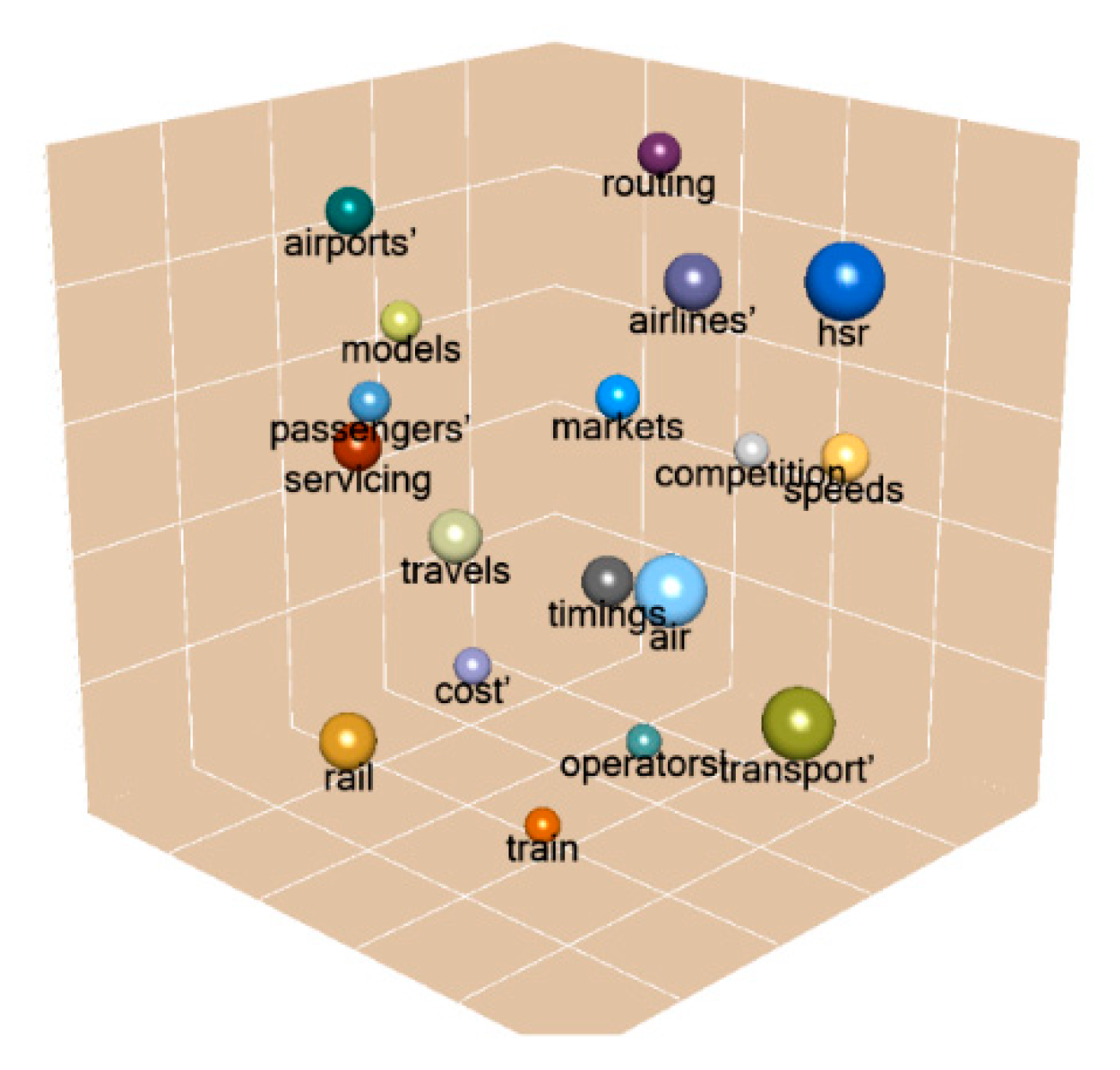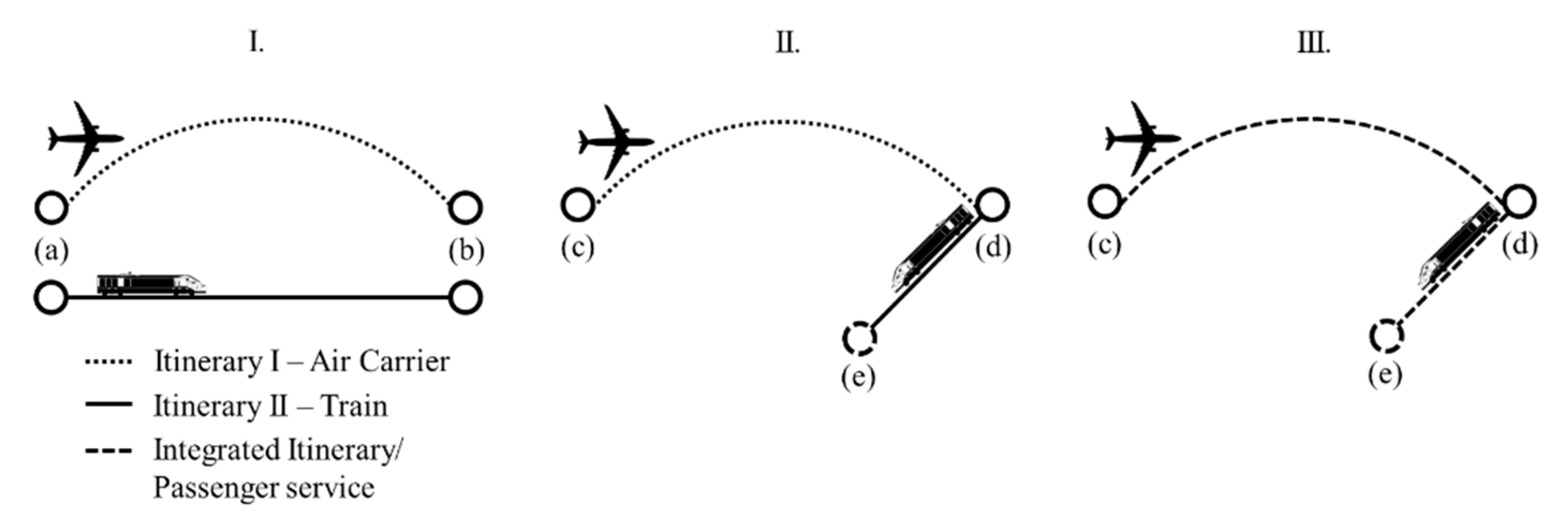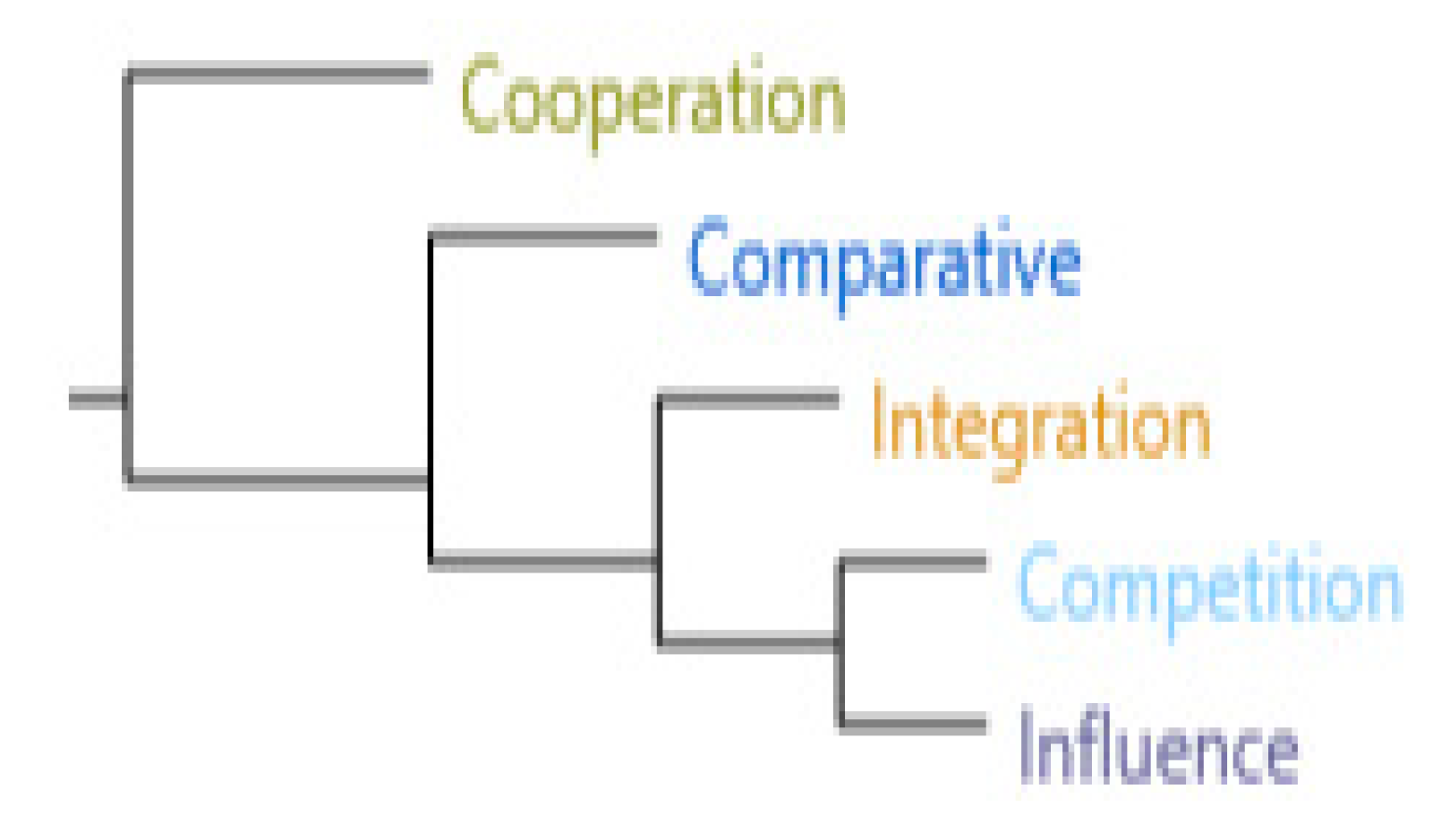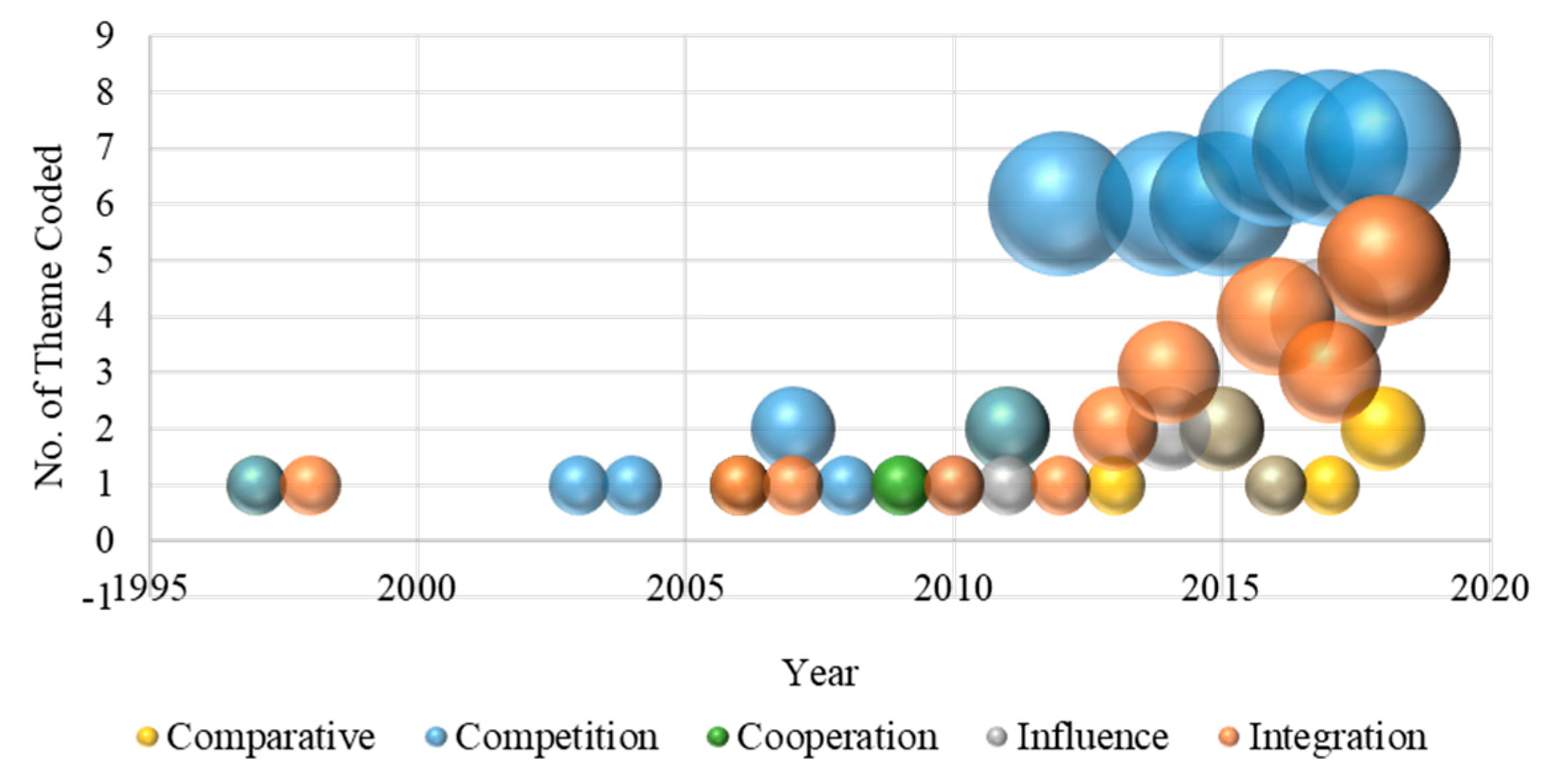Overview of Air-Rail Passenger Transport Relationship from 1997 to 2018 †
Abstract
:1. Introduction
2. Research Methodology
2.1. Preparation
2.1.1. Article Search Words
2.1.2. Publication Year
2.1.3. Language
2.1.4. Scope of articles
2.2. Analysis
3. Result and Discussion
3.1. Analysis of Word Frequency
3.2. Classification of Research Theme
3.3. Trend Analysis
4. Conclusions
References
- Milan, J. Comparison of the quality of rail and air networks in West, Central and Eastern Europe. Transp. Policy 1997, 4, 85–93. [Google Scholar] [CrossRef]
- Givoni, M. Aircraft and High Speed Train Substitution: The Case for Airline and Railway Integration. Ph.D. Thesis, University College, London, UK, February 2005. [Google Scholar]
- Stubbs, J.; Jegede, F. The integration of rail and air transport in Britain. J. Transp. Geogr. 1998, 6, 53–67. [Google Scholar] [CrossRef]
- Givoni, M.; Banister, D. Airline and railway integration. Transp. Policy 2006, 13, 386–397. [Google Scholar] [CrossRef]
- Clewlow, R.R.; Sussman, J.M.; Balakrishnan, H. The impact of high-speed rail and low-cost carriers on European air passenger traffic. Transp. Policy 2014, 33, 136–143. [Google Scholar] [CrossRef]
- Dobruszkes, F.; Dehon, C.; Givoni, M. Does European high-speed rail affect the current level of air services? An EU-wide analysis. Transp. Res. Part A 2014, 69, 461–475. [Google Scholar] [CrossRef]
- Wan, Y.; Ha, H.-K.; Yoshida, Y.; Zhang, A. Airlines’ reaction to high-speed rail entries: Empirical study of the Northeast Asian market. Transp. Res. Part A 2016, 94, 532–557. [Google Scholar] [CrossRef]
- Chen, Z. Impacts of high-speed rail on domestic air transportation in China. J. Transp. Geogr. 2017, 62, 184–196. [Google Scholar] [CrossRef] [PubMed]
- Zhang, Q.; Yang, H.; Wang, Q. Impact of high-speed rail on China’s Big Three airlines. Transp. Res. Part A 2017, 98, 77–85. [Google Scholar] [CrossRef]
- Yang, H.; Burghouwt, G.; Wang, J.; Boonekamp, T.; Dijst, M. The implications of high-speed railways on air passenger flows in China. Appl. Geogr. 2018, 97, 1–9. [Google Scholar] [CrossRef] [PubMed]
- Zhang, F.; Graham, D.J.; Wong, M.S.C. Quantifying the substitutability and complementarity between high-speed rail and air transport. Transp. Res. Part A 2018, 118, 191–215. [Google Scholar] [CrossRef]
- Hsieh, H.-F.; Shannon, S.E. Three approaches to qualitative content analysis. Qual. Health Res. 2005, 15, 1277–1288. [Google Scholar] [CrossRef] [PubMed]
- Cullinane, K.; Toy, N. Identifying influential attributes in freight route/mode choice decisions: A content analysis. Transp. Res. Part E 2000, 36, 41–53. [Google Scholar] [CrossRef]
- Spens, K.M.; Kovacs, G. A content analysis of research approaches in logistics research. Int. J. Phys. Distrib. Logist. Manag. 2005, 36, 374–390. [Google Scholar] [CrossRef]
- Ahi, P.; Searcy, C. A comparative literature analysis of definitions for green and sustainable supply chain management. J. Clean. Prod. 2013, 52, 329–341. [Google Scholar] [CrossRef]
- Mahpula, A.; Yang, D.; Kurban, A.; Witlox, F. An overview of 20 years of Chinese logistics research. J. Transp. Geogr. 2013, 31, 30–34. [Google Scholar] [CrossRef]
- Moldavska, A.; Welo, T. The concept of sustainable manufacturing and its definitions: A content-analysis based literature review. J. Clean. Prod. 2017, 166, 744–755. [Google Scholar] [CrossRef]
- Okoli, C.; Schabram, K. A guide to conducting a systematic literature review of information systems research. Sprouts Work. Pap. Inf. Syst. 2010, 10, 1–49. [Google Scholar] [CrossRef]
- Li, X.; Jiang, C.; Wang, K.; Ma, J. Determinants of partnership levels in air-rail cooperation. J. Air Transp. Manag. 2018, 71, 88–96. [Google Scholar] [CrossRef]
- Chen, X.; Lin, L. The Integration of Air and Rail Technologies: Shanghai’s Hongqiao Integrated Transport Hub. J. Urban Technol. 2016, 23, 23–46. [Google Scholar] [CrossRef]
- Mathur, S.; Srinivasan, S. High-speed rail in the midwest united states: Potential for success. Theor. Empir. Res. Urban Manag. 2009, 4, 59–74. [Google Scholar]
- Takebayashi, M. The future relations between air and rail transport in an island country. Transp. Res. Part A 2014, 62, 20–29. [Google Scholar] [CrossRef]




| Node A | Node B | Pearson Correlation Coefficients |
|---|---|---|
| Influence | Competition | 0.698 |
| Integration | Competition | 0.688 |
| Integration | Influence | 0.583 |
| Competition | Comparative | 0.530 |
| Integration | Comparative | 0.449 |
| Influence | Comparative | 0.425 |
| Integration | Cooperation | 0.364 |
| Cooperation | Competition | 0.240 |
| Influence | Cooperation | 0.195 |
| Cooperation | Comparative | 0.172 |
| Area | 1990s | 2000s | 2010s | Last 2 Years | Total | |||||
|---|---|---|---|---|---|---|---|---|---|---|
| No. | % | No. | % | No. | % | No. | % | No. | % | |
| China | 0 | 0.0% | 0 | 0.0% | 16 | 19.8% | 10 | 12.3% | 16 | 19.8% |
| Europe | 2 | 2.5% | 6 | 7.4% | 31 | 38.3% | 6 | 7.4% | 39 | 48.1% |
| Other | 0 | 0.0% | 2 | 2.5% | 24 | 29.6% | 10 | 12.3% | 26 | 32.1% |
| Total | 2 | 2.5% | 8 | 9.9% | 71 | 87.7% | 26 | 32.1% | 81 | |
© 2020 by the authors. Licensee MDPI, Basel, Switzerland. This article is an open access article distributed under the terms and conditions of the Creative Commons Attribution (CC BY) license (http://creativecommons.org/licenses/by/4.0/).
Share and Cite
Peetawan, W. Overview of Air-Rail Passenger Transport Relationship from 1997 to 2018. Proceedings 2019, 39, 11. https://doi.org/10.3390/proceedings2019039011
Peetawan W. Overview of Air-Rail Passenger Transport Relationship from 1997 to 2018. Proceedings. 2019; 39(1):11. https://doi.org/10.3390/proceedings2019039011
Chicago/Turabian StylePeetawan, Waralee. 2019. "Overview of Air-Rail Passenger Transport Relationship from 1997 to 2018" Proceedings 39, no. 1: 11. https://doi.org/10.3390/proceedings2019039011
APA StylePeetawan, W. (2019). Overview of Air-Rail Passenger Transport Relationship from 1997 to 2018. Proceedings, 39(1), 11. https://doi.org/10.3390/proceedings2019039011




